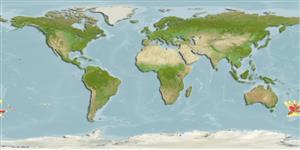| Native range | All suitable habitat | Point map | Year 2100 |

|
| This map was computer-generated and has not yet been reviewed. |
| Zearaja nasuta AquaMaps Data sources: GBIF OBIS |
Length at first maturity
Lm 59.0 range ? - ? cm
Human uses
Fisheries: commercial
Phylogenetic diversity index
(Ref. 82805)
PD50 = 0.6250 many relatives (e.g. carps) 0.5 - 2.0 few relatives (e.g. lungfishes)
Trophic Level
(Ref. 69278)
3.7 ±0.57 se; Based on food items.
Resilience
(Ref. 69278)
Low, minimum population doubling time 4.5 - 14 years (Fec assumed to be <100)